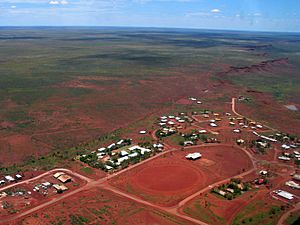Susie Bootja Bootja Napaltjarri facts for kids
Quick facts for kids
Susie Bootja Bootja Napaltjarri
|
|
|---|---|
| Born | c.1935 Kurtal, south-west of Balgo, Western Australia
|
| Died | 16 January 2003 |
| Nationality | Australian |
| Known for | Painting |
Susie Bootja Bootja Napaltjarri (born around 1935 – died 2003) was an important Indigenous artist. She came from the Western Desert area of Australia. She was also known by other names like Susie Bootja Bootja Napangardi.
Susie Bootja Bootja was born near Balgo, Western Australia. In the 1950s, she married fellow artist Mick Gill Tjakamarra. They had a son, Matthew Gill Tjupurrula, who also became an artist.
Susie Bootja Bootja started her painting career after the Warlayirti Artists art centre opened in Balgo. She became one of the strongest artists in her area. Her paintings are known for their expressive style. Major Australian art galleries, like the Art Gallery of New South Wales and National Gallery of Victoria, have bought her work.
Contents
About Susie Bootja Bootja
Susie Bootja Bootja was born around 1935 near a place called Kurtal. This area is south-west of Balgo, Western Australia. In her language, this land is called Kaningarra.
It can be hard to know the exact birth year for some Indigenous Australians. This is because they often used different ways to mark time. They might compare dates to other important events.
Susie Bootja Bootja belonged to the Kukatja language group. She married artist Mick Gill Tjakamarra in the 1950s. Their son, Matthew Gill Tjupurrula, was born in 1960 and also became an artist. Susie Bootja Bootja passed away on January 16, 2003.
What is a Skin Name?
'Napaltjarri' is a special name called a 'skin name'. Indigenous people in central Australia use these names. They help show how people are related to each other. Skin names also help decide who can marry whom. They can be used when talking to someone. But they are not like family names (surnames) that Europeans use. So, 'Susie Bootja Bootja' is the part of her name that is just for her.
Susie Bootja Bootja's Art
How Indigenous Art Began
Modern Indigenous art from the Western Desert started in 1971. This happened when Indigenous men in Papunya began painting. A teacher named Geoffrey Bardon helped them. They used acrylic paints to create designs. These designs were like the body paintings and ground sculptures used in ceremonies.
This new art style quickly spread across central Australia. By the 1980s and 1990s, these artworks were shown all over the world. At first, only men painted. But many women also wanted to create art. In the 1990s, many Indigenous women started painting.
Her Painting Career
The Balgo community opened its art centre, Warlayirti Artists, in 1981. It became one of Australia's most successful Indigenous art centres. Painting at the centre was a fun, group activity. Susie Bootja Bootja often painted with other artists, including her husband.
Susie Bootja Bootja was one of the strongest painters at Balgo. Her work, and that of other Balgo artists, has a special expressive style. This style often uses "linked dotting and blurred forms and edges."
You can find Susie Bootja Bootja's artworks in many places. These include the Art Gallery of New South Wales and the National Gallery of Victoria. Her art is also in private collections. Her paintings were shown in exhibitions in Paris and at the Art Gallery of Western Australia.
Susie Bootja Bootja also helped with a 1993 film called Milli Milli. She helped choose the place for a big ceremony shown in the film. She also took part in the ceremony with other artists.
Where to See Her Art
- Art Gallery of New South Wales
- Flinders University Art Museum Collection
- National Gallery of Victoria
- Kluge-Ruhe Aboriginal Art Collection, University of Virginia
- Holmes à Court collection
See also
 In Spanish: Susie Bootja Bootja Napaltjarri para niños
In Spanish: Susie Bootja Bootja Napaltjarri para niños


